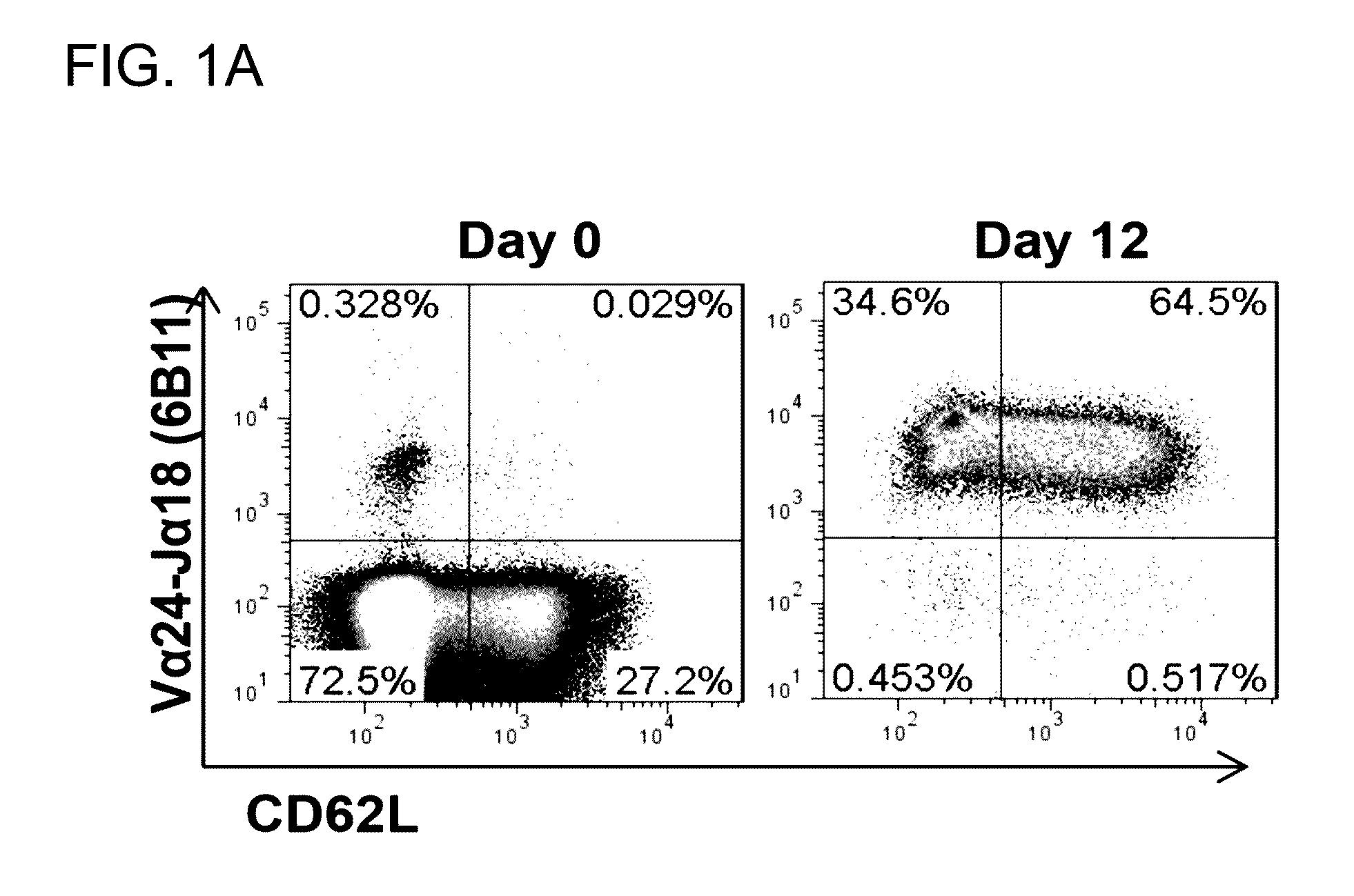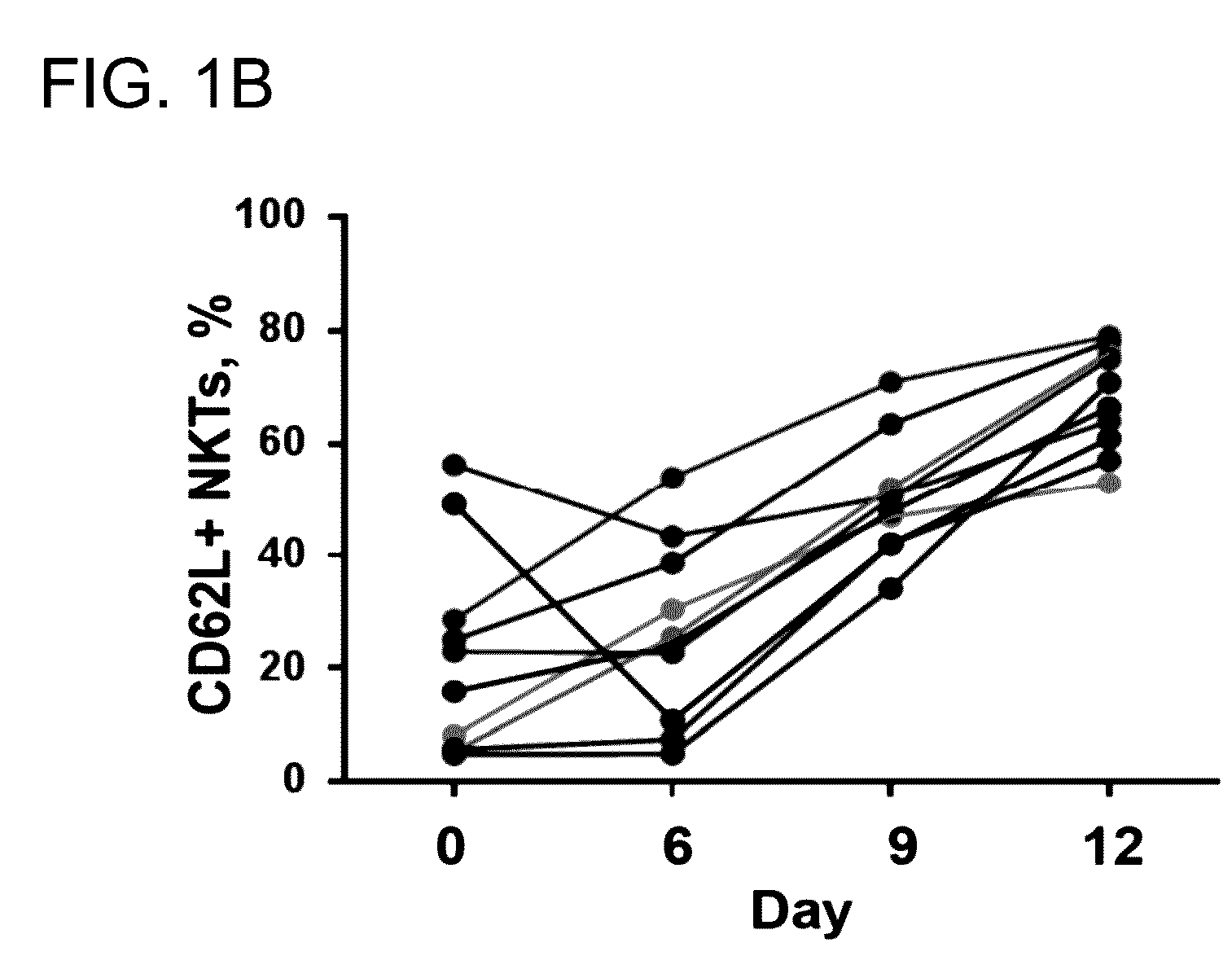Nkt-cell subset for in vivo persistence and therapeutic activity and propagation of same
a nkt-cell and in vivo persistence technology, applied in the field of cell biology, molecular biology, immunology, and medicine, can solve the problems of limiting the rational design of nkt-cell-based cancer immunotherapy, and achieve the effects of enhancing survival and expansion, superior in vivo persistence and anti-tumor activity, and effective cancer immunotherapy
- Summary
- Abstract
- Description
- Claims
- Application Information
AI Technical Summary
Benefits of technology
Problems solved by technology
Method used
Image
Examples
example 1
The Identification of the NKT-cell Subset Responsible for In Vivo Persistence and Therapeutic Activity and Defining the Conditions Required for Propagation of This Subset in Culture
[0098]The adoptive transfer of invariant Natural Killer T cells (NKTs) is being developed as a promising therapeutic modality for immunotherapy of cancer, autoimmunity, and other diseases. Because NKT-cell frequency is low in human peripheral blood, such therapies require extensive ex vivo expansion of primary NKTs while preserving their longevity and function. However, cellular and molecular mechanisms responsible for the maintenance of NKTs either in vivo or ex vivo remain largely unknown. Here it is demonstrated that antigen-induced in vitro expansion of primary human NKTs is associated with the progressive accumulation of CD62L-positive subset in all 5 examined individuals regardless of the initial frequency of that subset. Following magnetic sorting of NKTs into CD62L-positive and CD62L-negative subs...
example 2
CD62L+ NKT Cells Have Superior In Vivo Persistence and Anti-Tumor Activity
[0100]CD62L+ cells accumulate in culture upon antigenic stimulation of primary NKTs. Previous studies that compared the phenotype of human NKTs in adult peripheral blood with that in cord blood observed much higher proportions of CD4+ and CD62L+ NKTs in neonates (Baev et al., 2004; D'Andrea et al., 2000; Eger et al., 2006) (FIG. 5A). The prevalence of CD4+CD62L+ NKTs in cord blood suggests that the expression of CD4 or / and CD62L marks a subset of NKTs that has superior developmental potential and could support ex vivo expansion of NKTs for therapeutic applications. To test this embodiment, immunophenotyping was performed of primary NKTs immediately after isolation from peripheral blood and at different time intervals in culture after stimulation with αGalCer, which consistently produced higher frequency and absolute numbers of NKTs compared to the use of a T-cell expansion protocol based on CD3 / CD28 stimulatio...
example 3
Examples of Methods and Materials
[0114]Cell lines and culture conditions. Daudi, Raji, DAOY, Ramos and 293T cells were purchased from ATCC. Daudi, Raji, and Ramos cells were cultured in RPMI, whereas DAOY and 293T cells were maintained in IMDM (Invitrogen). Both types of medium were supplemented with 10% FBS (Hyclone), 2 mM G1utaMAX-1 (Gibco-BRL).
[0115]NKT-cell isolation, transduction, expansion and sorting. To analyze the cord blood NKT cells discarded cord blood units obtained from MD Anderson Cancer Center Cord Blood Bank were used according to the protocols approved by the Institutional Review Boards at MD Anderson Cancer Center and Baylor College of Medicine. PBMC of healthy donors (at least 18 years old) were isolated by gradient centrifugation from buffy coats purchased from Gulf Coast Regional Blood Center. NKTs were purified by anti-iNKT microbeads (Miltenyi Biotec). The negative PBMC fraction was irradiated (40 Gy) and aliquoted. NKTs were stimulated with an aliquot of aut...
PUM
| Property | Measurement | Unit |
|---|---|---|
| concentrations | aaaaa | aaaaa |
| concentrations | aaaaa | aaaaa |
| concentrations | aaaaa | aaaaa |
Abstract
Description
Claims
Application Information
 Login to View More
Login to View More - R&D
- Intellectual Property
- Life Sciences
- Materials
- Tech Scout
- Unparalleled Data Quality
- Higher Quality Content
- 60% Fewer Hallucinations
Browse by: Latest US Patents, China's latest patents, Technical Efficacy Thesaurus, Application Domain, Technology Topic, Popular Technical Reports.
© 2025 PatSnap. All rights reserved.Legal|Privacy policy|Modern Slavery Act Transparency Statement|Sitemap|About US| Contact US: help@patsnap.com



